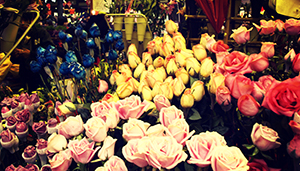
Whether you’re shopping for souvenirs or simply want a glimpse of local life in Guangzhou, a visit to one of these popular markets and commercial streets is a great way to spend an afternoon.
Wedding Street
One of Guangzhou’s most famous shopping hubs, Wedding Street on Jiang Nan Dadao is packed with ruby red qipaos (traditional Chinese wedding dresses) and plenty of ornamented white gowns. It’s more of an area than a single street, with independent boutiques packed into indoor complexes and spilling over into nearby alleyways. The sheer variety is overwhelming – find shoes, bridesmaids’ dresses, veils or tuxedos. You can even have a designer dress replicated for a fraction of the retail price. The process takes about a week, and you can expect to pay 5,000-6,000 RMB (about $800 to $950 USD) for a quality gown, though having a Putonghua-speaking friend tag along will improve your bargaining power.
Flower Markets
Guangzhou has several nicknames, but perhaps the most flattering is “Huacheng,” meaning “City of Flowers,” thanks to perennial blossoms lining the streets. You’ll likely catch whiffs of sweet jasmine as you wander through town, but nowhere is the moniker more earned than at the annual Flower Fairs. Every year since the first fair, which is said to have taken place during the Ming Dynasty, Guangzhou has turned into one big river of blossoms in the days preceding Chinese New Year, also called Spring Festival. These huge flower fairs (early February) pop up all over the city and attract thousands of visitors looking for lucky red blooms to bring them wealth, peace and love in the new year.
Hualin Jade Street
If it’s jewelry you’re after, then make a beeline to buzzing Hualin Jade Street, where a vast majority of Guangzhou’s jade dealers set up shop along Xia-jiu Lu and inside the Hualin Building to sell their bangles, pendants and enormous sculptures – some with price tags approaching 10,000 RMB (around $1,600). On either side of the crowded lane, vendors sell multihued jade jewelry and elaborately carved sculptures displaying remarkable craftsmanship. Though the legitimate, glass-fronted shops are closely regulated, you’ll still have to be on the lookout for fakes, particularly from wandering hawkers.
Xiguan Antique Market
A 1,640-foot-long street near Liwan Park, Xiguan Antique Market is a reputable place to snap up Chinese ceramics, rare scripts and beautiful calligraphy sets, thanks to careful monitoring by the government. You’ll find some 150 shops along the street and inside the indoor complex, and it’s not uncommon to stumble upon an auction or an exhibition of sorts. Can’t commit to a Tang Dynasty relic worth 15,000 RMB (nearly $2,400)? Not to worry, the market is filled with smaller knickknacks and curios that won’t empty your pockets.
Qingping Market
The entrance to the Qingping Market is conveniently located right across the street from Shamian Island at the intersection of Qingping and Tiyun streets. A casual walk around this sprawling matrix of indoor and outdoor stores rewards you with a look – and smell – of ancient Chinese medicine. The crowded, colorful outdoor shops carry everything from big baskets of dried fungi to fish maw drying on racks. If it’s a hot and humid day, do your browsing in one of the cooler indoor markets.
Guihuagang Leather Market
Have your heart set on a new carryall? You’re in luck. A colossal cluster of buildings in the Baiyun District, the Guihuagang Leather Market happens to be the purse mecca of China. It’s the country’s largest wholesale leather market, attracting bulk buyers and curious tourists from all over the world. Whether you’re after smaller wallets or big, beautiful totes, you can find them all here thanks to a stable of hundreds of leather brands. Though certain sections of the market focus on bulk businesses purchases, many retailers will entertain one-off purchases so you don’t go home empty-handed.



